I would rate red mites as being one of the biggest problems you will face when keeping chickens. Red Mites live in the cracks of chicken houses (typically under perch ends) coming out at night, crawling onto your birds for a feed.
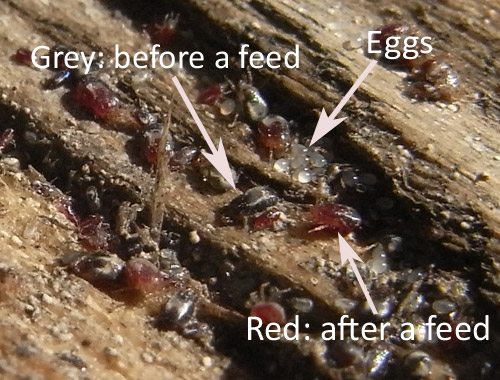
Macro shot of Red Mite in a crack on a perch. These were disturbed after a treatment with Poultry Shield.
They start off as very small greyish-white mites that swell up into red coloured mites after a feed and at their biggest are only 1mm so small numbers of them can be hard to spot unless you know what to look for.
You will often find a grey ash like deposit around perch ends which is where the mites have been and if you lift the perch, you will see clumps of mites.
Red Mite in chickens’ houses are active during the warmer months, usually May to October and will become dormant over the winter. They multiply at an incredible rate: their life cycle is just 7-10 days. In other words from hatching from an egg to being an adult laying hundreds of eggs takes just a week if conditions are right.
Be Proactive.
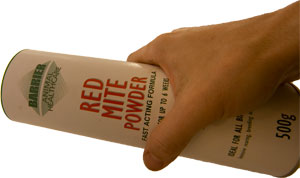 The best course of action is to check for red mite routinely when you clean your chicken house out and use some preventative treatment to the house before they get a hold. You will get to know the places to look and once you have found small numbers of them, you can treat the house to keep numbers under control. See my ‘preventative measures’ below
The best course of action is to check for red mite routinely when you clean your chicken house out and use some preventative treatment to the house before they get a hold. You will get to know the places to look and once you have found small numbers of them, you can treat the house to keep numbers under control. See my ‘preventative measures’ below
Are there Red Mite in your Chicken House?
People normally discover Red Mite when they are over-run by them. When hens are being bitten, they can refuse to go in to roost at night, they will become anaemic and their combs will go pale. They will often stop laying and you may find red blood stains on eggs (squashed Red Mites). Eventually, you will start to see losses in the flock.
Checking for Red Mite in Chickens Houses
Red Mite will hide away in the daytime but can often be seen if you lift perches, examining the ends. They will usually come swarming out if you treat the cracks with Poultry Shield but by far the easiest way to check to see if there are red mite is to take a piece of white kitchen roll and to rub it along the underside of the perch when your hens are roosting (in the dark). Look at the tissue and if there are Red Mite heading back from their feed, they will be squashed on the kitchen roll as streaks of blood.
Getting rid of Red Mite
It is very hard to get rid of them completely so it is often better to get the numbers down and then find a way of keeping them down that doesn’t involve you spending hours on cleaning the house out. There are lots of different treatments that people use, some more effective than others but I will focus on what I do and have found to be the most successful for me.
If you haven’t got red mite and the weather is warm enough for them (May to October in the UK) then skip step 1 and go straight to step 2. Preventative Measures.
1. Getting rid of an infestation.
If you find lots of red mite in the coop, it’s time for a big clean up that will take a couple of hours initially, then an hour every 5 to 7 days for at least 2 more weeks.
The products I have found to work the best (that are relatively safe) are Poultry Shield and Diatom. These two are not ‘knock down’ products as such, they do take a little while to work but are none the less very effective. I also use Red Mite Powder on the hens themselves to help them through the night when the Mites are active.
You can BUY Poultry Shield from Amazon Here.
Here is what I do with the Poultry Shield.
- Remove all birds from the house.
- Strip the house down as much as possible.
- Clean the house out – be careful where the bedding is going as red mite live for 6 months without a feed and will find a new home If they can. Ideally seal the bedding in bin bags or burn.
- Mix up as many watering cans of poultry shield mixture as is needed, as per the instructions on the label 1 part to 9 parts water.
- ‘Water’ all cracks in the chicken house, concentrating where there are perch ends and concentrations of red mite.
- Leave to soak for 15 minutes
- Red mites will be coming out. Cover them and the cracks with poultry shield again.
- Wait 15 minutes
- Hose out the house, concentrating on getting the pressure jet into the cracks and so on.
- Leave the house to dry.
Poultry Shield is a mild detergent and ‘washes’ the waxy coat off the red mites. It is also good for removing organic matter from the hen house so is useful for cleaning. I wouldn’t be without this!
After using the Poultry Shield, when the house is dry, I use Diatom. Diatom is made of micro skeletons of fossilised remains of diatoms. These were once a kind of algae found in water. They are microscopically sharp and pierce the outer waxy coating of the mites which causes them to dry out and die.
The second step also double up as my ‘preventative’ measures if you haven’t yet got a bad infestation
You can BUY Diatom from Amazon HERE
2. Preventative Measures
- Dust the ends of the perches / nest boxes and where ever else you found concentrations of red mites when cleaning.
- Rub as much into the perches as you can. Red mite will avoid the diatom and will crawl around it if they can, so make sure they have to crawl through it to get a feed.
- Repeat every couple of days for as long as you see signs of red mite in the coop.
Repeat the whole cleaning process if there are still lots of mites in 5 to 7 days. You will find you might not need to spend as long on the washing as there won’t be as many mites.
Very Important: Make sure you repeat it before 7 days so that the mites don’t have a chance to lay more eggs. A few mites become a lot in a very short space of time!
If you have a felt roof on your chicken house and they get underneath, it is usually impossible to get rid of them without removing the felt, cleaning and re-felting. My page on Chicken Houses gives more information.
Finally, I will dust the hens down between their feathers with Red Mite Powder to give them some respite during the night when the mites are active.
Beware of what you read!
There is a lot of information written about these troublesome ectoparasites on the internet these days, much of it re-written and re-spun. When I started writing about them, there was little available online. Strangely, some small errors that I had introduced on my page that I corrected in an update pop up frequently on other websites. Running a Google image search often uncovers companies that have used my copyrighted images! I make regular checks to try to stop this from happening.
If you wish to learn more about red mite then I would encourage you to read the guide to red mite on poultrykeeper.com. This is a reliable source of information and is regularly updated.

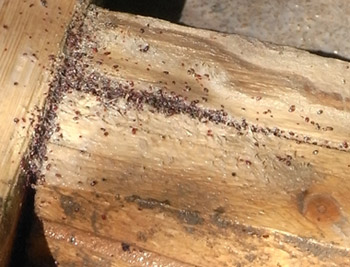

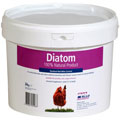

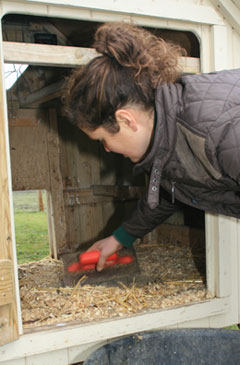
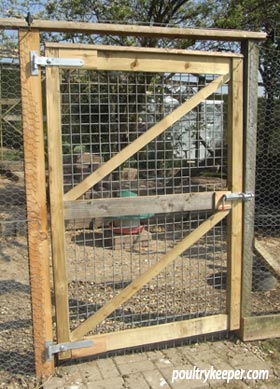
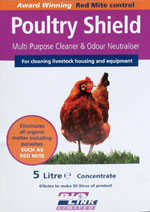
I have only just started up my chicken coop in the last 2 months . I clean out the run every day and their bedding every 2 days to which I always spinkle with mite powder especially around their perch.
I have 2 large dogs which are regularly front lined @ wormed , but , they won’t stop scratching now ? I believe they have picked up mites and I’m not sure how to go about treating . Can you advise please
First, I would check the dogs over. It is unlikely to be red mite but if it is, you should be able to find them without too much difficulty.
I would also check for fleas. It has been a bad year for fleas due to the weather and although you have been using Frontline, vets have suggested this sometimes isn’t 100% effective and use other (prescription) flea treatments. This is especially true if fleas are hopping on from a dog bed or elsewhere after the treatment.
Do red mite spred to near building . We have a run near a wooded extension was wondering would they spred to there .
Thanks steve
Only if they can get carried in on clothing or on animals…
We are battling red mite too. Blow torch, diatom ,poultry guard , fumigator bombs and red mite powder and still they come. Chickens seem totally unconcerned by them. We’ve stopped using straw in nest box. Use just sawdust and shredded paper. Unfortunately they seem to love me and the dog but just wash off my husband. I only have to walk down the garden and I’m covered in them. I strip at the door and either boil the clothes or dump in a bag in the freezer then you can wash them at any temperature as the mites die. The dog is currently banned from the garden as she goes crazy with them. They bite her as when I squash them they contain bright red blood. The ones off me don’t. I’ve kept hens for 4 years and never had this problem before even nursing sick hens in the kitchen in a carrier before. …… Now I just want them gone along with the mites.
Feel for you and similar problems this summer. one of our dogs has dermatitis is anyway and dreading the red mites causing problems. We have working birds of prey and worried they might pick them up.
Only had chickens 18months and if I didn’t love my girls so much I would be calling it a day!
Hi Jan! I know this is more than three years later, but did you ever get rid of them? The mites LOVE me and my dog, but not my husband and daughter, (thankfully). I’m SO OVER IT, but they are our pets and I think my 5 year old will be devastated if we get rid of them. I just wanted to know, did you end up getting rid of your birds?
Hi,
I went to my vet and he gave me some Noramectin. You put a couple of drops on your chickens and it paralyses the mite when they take a feed. My vet charged me 33p in total for enough drops for 4 chickens so it is not expensive to do. This product is not licenced for use on chickens but is very effective. At the same time we used this we used a chicken house fumer which killed thousands of the mites in one go. We have now been mite clear for a good month. You can teat the chickens every 6 months with the Noramectin so we will be using it as a preventative course of action next year.
I believe this contains Ivomectin – which is something many chicken keepers will buy on-line and use, even though it isn’t licensed for chickens. It also kills quite a few worm species so has a double use. The poultrykeeper.com website has a useful page on Ivomectin.
Noromectin doesn’t contain Ivermectin (note spelling), it IS Ivermectin. A generic drug it can go under many names and Noromectin is simply the brand name that particular manufacturer has chosen. It’s a broad spectrum insecticide and is definitely one of the two insecticides that poultry keepers use routinely (the other being Permethrin). Fipronil is often used too (often branded as ‘Frontline’) but works in a different way and is very expensive and not as effective as the other two (in my opinion). For those not keen on the pharmaceutical approach I’ve found Creocote (non carcinogenic version of Creosote) to be highly effective against red mites.
To be clear.. Noromectin will contain an amount of Ivermectin often shown as a percentage on the packaging so I wouldn’t say Noromectin is Ivermectin.
I have today purchased a can of “Total Mite Kill” which contains permethrin and piperonyl butoxide to try and reduce my mite infestation. I have 3 hens which so far don’t themselves look any worse for wear but they are definitely not laying as well as they were. We did not initially think we had red mites as we could see them walking around the coop throughout the day but now I think they can’t be anything else. The black residue in cracks and corners is ever increasing. The instructions on the spray can don’t say how long after spraying you can let the hens back in the coop. I guess a couple of hours? Presumably this stuff is not harmful to hens if used correctly? Also, if the mites do get on us humans will they suck our blood too or just crawl over us causing us to itch. I am definitely itchy but haven’t seen any creatures on me. Ugh.
I would keep the hens shut out for a few hours, mainly to let the air clear but also any solution dry off.
Thanks for these tips I have just become infested after having chickens for 2 yrs and it’s awful! I thought red mite I only came out at night but people are commenting on being covered by them just walking in the garden??
I would check that they are definitely red mites, I haven’t found them outside of the chicken house before, they like hiding away in the dark cracks.
I have a large chicken house, 14ft by 8ft and some times we get red mite. This year has been really bad due to the warm weather. This is what we’ll do:- clean out the whole shed, wash it off with steam cleaner, let it dry and paint with creosote inside. Yes drastic I know but it works, the next day you can see them all dead – millions of them. We worm the chickens at the same time because the creosote taints the taste of the eggs, fortunately its the time of year when they are not laying over well and as you can’t eat egg when chickens are wormed it works well for us. I can do this in a day. No chicken has died on us yet and our house has a lot of ventilation. Its also works out very cheap. People I know use red diesel but I don’t like the smell. We also put mite dust on chickens
Just a quick comment Jane – if you use Flubenvet to worm the chickens, provided you use it at the stated dose on the label, you can still eat the eggs.
If eggs are getting tainted by creosote, I would try to leave the coop to air for longer. If it’s the old fashioned creosote, it contains some really strong chemicals (which is why it was banned for domestic use) so do take extra care not to touch it with bare hands, they say it can cause cancer.